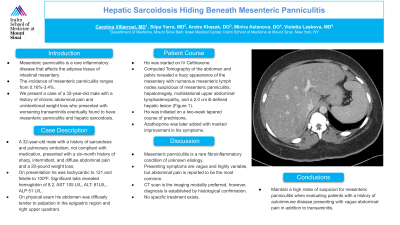Back


Poster Session A - Sunday Afternoon
Category: Liver
A0532 - Hepatic Sarcoidosis Hiding Beneath Mesenteric Panniculitis
Sunday, October 23, 2022
5:00 PM – 7:00 PM ET
Location: Crown Ballroom

Has Audio

Carolina Villarroel, MD
Mount Sinai Beth Israel
New York, NY
Presenting Author(s)
Carolina Villarroel, MD, Silpa Yarra, MD, Andre Khazak, DO, Minira Aslanova, DO, Violetta Laskova, MD
Mount Sinai Beth Israel, New York, NY
Introduction: Mesenteric panniculitis is a rare inflammatory disease that affects the adipose tissue of intestinal mesentery. The incidence of mesenteric panniculitis ranges from 0.16%-3.4%. Though its etiology is unknown, it has been linked to a range of conditions including vasculitides, malignancies, abdominal trauma, and autoimmune diseases. We present a case of a 32-year-old male with a history of chronic abdominal pain and unintentional weight loss who presented with worsening transaminitis eventually found to have mesenteric panniculitis and hepatic sarcoidosis.
Case Description/Methods: A 32-year-old male with a history of sarcoidosis and pulmonary embolism, not compliant with medication, presented to the emergency department with a six-month history of sharp, intermittent, and diffuse abdominal pain. He denied any fevers, nausea, vomiting, diarrhea, changes in medications or diet, recent travel, or sick contacts. He also endorsed a 20-pound weight loss. On presentation, he was tachycardic to 121 and febrile to 100F. Labs were significant for a hemoglobin of 8.2, AST 105 U/L, ALT: 81U/L, and ALP 51 U/L. On physical exam, the abdomen was diffusely tender to palpation in the epigastric region and right upper quadrant. He was started on IV Ceftriaxone. Computed Tomography (CT) of the abdomen and pelvis revealed a hazy appearance of mesentery with numerous mesenteric lymph nodes suspicious of mesenteric panniculitis, hepatomegaly, multistational upper abdominal lymphadenopathy, and a 2.0 cm ill-defined hepatic lesion (Figure 1). Percutaneous liver biopsy revealed hepatic sarcoidosis and mesenteric panniculitis. He was initiated on a two-week tapered course of prednisone. Azathioprine was later added with marked improvement in his symptoms.
Discussion: Mesenteric panniculitis is a rare fibroinflammatory condition of unknown etiology. There is limited understanding of the pathogenic mechanism, but it has been linked to autoimmune processes. Presenting symptoms are vague and highly variable, but abdominal pain is reported to be the most common. CT scan is the imaging modality preferred, however, diagnosis is established by histological confirmation. No specific treatment exists, but steroids have demonstrated promising results. Our case illustrates the need for maintaining a high index of suspicion for mesenteric panniculitis when evaluating patients with a history of autoimmune disease presenting with vague abdominal pain in addition to transaminitis.

Disclosures:
Carolina Villarroel, MD, Silpa Yarra, MD, Andre Khazak, DO, Minira Aslanova, DO, Violetta Laskova, MD. A0532 - Hepatic Sarcoidosis Hiding Beneath Mesenteric Panniculitis, ACG 2022 Annual Scientific Meeting Abstracts. Charlotte, NC: American College of Gastroenterology.
Mount Sinai Beth Israel, New York, NY
Introduction: Mesenteric panniculitis is a rare inflammatory disease that affects the adipose tissue of intestinal mesentery. The incidence of mesenteric panniculitis ranges from 0.16%-3.4%. Though its etiology is unknown, it has been linked to a range of conditions including vasculitides, malignancies, abdominal trauma, and autoimmune diseases. We present a case of a 32-year-old male with a history of chronic abdominal pain and unintentional weight loss who presented with worsening transaminitis eventually found to have mesenteric panniculitis and hepatic sarcoidosis.
Case Description/Methods: A 32-year-old male with a history of sarcoidosis and pulmonary embolism, not compliant with medication, presented to the emergency department with a six-month history of sharp, intermittent, and diffuse abdominal pain. He denied any fevers, nausea, vomiting, diarrhea, changes in medications or diet, recent travel, or sick contacts. He also endorsed a 20-pound weight loss. On presentation, he was tachycardic to 121 and febrile to 100F. Labs were significant for a hemoglobin of 8.2, AST 105 U/L, ALT: 81U/L, and ALP 51 U/L. On physical exam, the abdomen was diffusely tender to palpation in the epigastric region and right upper quadrant. He was started on IV Ceftriaxone. Computed Tomography (CT) of the abdomen and pelvis revealed a hazy appearance of mesentery with numerous mesenteric lymph nodes suspicious of mesenteric panniculitis, hepatomegaly, multistational upper abdominal lymphadenopathy, and a 2.0 cm ill-defined hepatic lesion (Figure 1). Percutaneous liver biopsy revealed hepatic sarcoidosis and mesenteric panniculitis. He was initiated on a two-week tapered course of prednisone. Azathioprine was later added with marked improvement in his symptoms.
Discussion: Mesenteric panniculitis is a rare fibroinflammatory condition of unknown etiology. There is limited understanding of the pathogenic mechanism, but it has been linked to autoimmune processes. Presenting symptoms are vague and highly variable, but abdominal pain is reported to be the most common. CT scan is the imaging modality preferred, however, diagnosis is established by histological confirmation. No specific treatment exists, but steroids have demonstrated promising results. Our case illustrates the need for maintaining a high index of suspicion for mesenteric panniculitis when evaluating patients with a history of autoimmune disease presenting with vague abdominal pain in addition to transaminitis.

Figure: Figure 1: CT scan (axial view) showing focal lesion in the liver and mesenteric lymphadenopathy
Disclosures:
Carolina Villarroel indicated no relevant financial relationships.
Silpa Yarra indicated no relevant financial relationships.
Andre Khazak indicated no relevant financial relationships.
Minira Aslanova indicated no relevant financial relationships.
Violetta Laskova indicated no relevant financial relationships.
Carolina Villarroel, MD, Silpa Yarra, MD, Andre Khazak, DO, Minira Aslanova, DO, Violetta Laskova, MD. A0532 - Hepatic Sarcoidosis Hiding Beneath Mesenteric Panniculitis, ACG 2022 Annual Scientific Meeting Abstracts. Charlotte, NC: American College of Gastroenterology.
